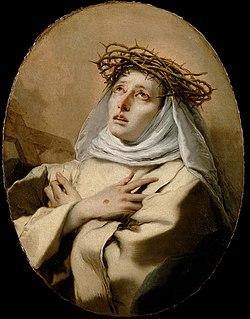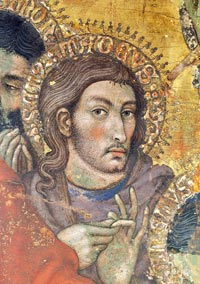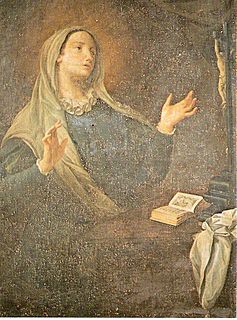Related Research Articles

Catherine of Siena , a lay member of the Dominican Order, was a mystic, activist, and author who had a great influence on Italian literature and on the Catholic Church. Canonized in 1461, she is also a Doctor of the Church.

Il Sodoma was the name given to the Italian Renaissance painter Giovanni Antonio Bazzi. Il Sodoma painted in a manner that superimposed the High Renaissance style of early 16th-century Rome onto the traditions of the provincial Sienese school; he spent the bulk of his professional life in Siena, with two periods in Rome.

Muzio Attendolo Sforza, was an Italian condottiero. Founder of the Sforza dynasty, he led a Bolognese-Florentine army at the Battle of Casalecchio.

Mazzorbo is one of various islands in the northern part of the Lagoon of Venice. Like the other islands in this part of the lagoon, it was the site one of the earliest settlements in the lagoon which predated the development of Venice. However, these islands then declined and were eventually abandoned. In the 1980s the architect Giancarlo De Carlo built a brightly coloured residential neighbourhood to help to repopulate Mazzorbo. In 2019 its population was 256. It is linked to Burano by a wooden bridge. It was once an important trading centre but is now known for its vineyards and orchards. Its main attraction is the fourteenth century church of Santa Caterina.

Taddeo di Bartolo, also known as Taddeo Bartoli, was an Italian painter of the Sienese School during the early Renaissance. He is among the artists profiled in Vasari's biographies of artists or Vite. Vasari claims he is the uncle of Domenico di Bartolo.

Catherine of Bologna [Caterina de' Vigri] was an Italian Poor Clare nun, writer, teacher, mystic, artist, and saint. The patron saint of artists and against temptations, Catherine de' Vigri was venerated for nearly three centuries in her native Bologna before being formally canonized in 1712 by Pope Clement XI. Her feast day is 9 March.

Catherine of Genoa was an Italian Roman Catholic saint and mystic, admired for her work among the sick and the poor and remembered because of various writings describing both these actions and her mystical experiences. She was a member of the noble Fieschi family, and spent most of her life and her means serving the sick, especially during the plague which ravaged Genoa in 1497 and 1501. She died in that city in 1510.

Santa Caterina a Magnanapoli is a baroque church dedicated to St. Catherine of Siena on Largo Magnanapoli on the slopes of the Quirinal Hill in Rome.

Sister Plautilla Nelli (1524–1588) was a self-taught nun-artist and the first known female Renaissance painter of Florence. She was a nun of the Dominican convent of St. Catherine of Siena located in Piazza San Marco, Florence, and was heavily influenced by the teachings of Savonarola and by the artwork of Fra Bartolomeo.

Lippo Memmi was an Italian painter from Siena. He was the foremost follower of Simone Martini, who was his brother-in-law.
The decade of the 1410s in art involved some significant events.

Astolfo Petrazzi (1583–1665) was an Italian painter of the Baroque period, active mainly in his hometown of Siena, but also Spoleto and Rome. He was a pupil of mainly Francesco Vanni, but also worked under Ventura Salimbeni and Pietro Sorri. He died in Siena.

Catherine de' Ricci, was an Italian Dominican Tertiary sister. She is believed to have had miraculous visions and corporeal encounters with Jesus, both with the infant Jesus and with the adult Jesus. She is said to have spontaneously bled with the wounds of the crucified Christ. She is venerated for her mystic visions and is honored as a saint by the Catholic Church.
Fra Serafino Razzi, was an Italian Dominican friar who in 1563 published a large collection of carnival songs in the lauda (song) genre. Razzi's collection Libro primo delle laudi spirituale is a miscellany of pieces of varying age and character from the music of Florence. It contains 91 lauda settings for one to four voices. Razzi travelled widely and kept diaries of his journeys.
Lucrezia Marinella (1571-1653) was an Italian poet, author, and an advocate of women's rights. She is best known for her writing The Nobility and Excellence of Women and the Defects and Vices of Men.

Sebastiano Folli (1568–1621) was an Italian painter of the late Renaissance period. He was a scholar of Alessandro Casolano, and a native of Siena. He distinguished himself by several frescoes in the churches at Siena, particularly the cupola of Santa Marta, and some subjects from the Life of St. Sebastian, in the church of that saint, painted in competition with Rutilio Manetti, to whose pictures they are in no way inferior. He visited Rome, and was employed in some considerable works for the Cardinal de' Medici, afterwards Leo XI. He died in 1621.
Suor Prudenza Fiammetta Cambi was a Florentine nun and artist during the sixteenth century at Santa Caterina da Siena in Florence, Italy. She has been identified as one of Plautilla Nelli’s artistic ‘disciples.’

Lucrezia Quistelli della Mirandola (1541–1594) was an Italian painter.
Diodata Malvasia was a nun within the convent of San Mattia in Bologna, Italy. She lived during the period of ecclesiastical reform that arose from the Council of Trent. She is known for being a prolific author, having published Brief Discourseon What Occurred to the Most Reverend Sisters of the Joined Convents of San Mattia and San Luca from the year 1573 (1575) and The Arrival and the Miraculous Workings of the Glorious Image of the Virgin Painted by Saint Luke (1617), and for having been involved in other literary works of her time.

Santa Caterina d'Alessandria or Saint Catherine of Alexandria is a Roman Catholic church with a main facade on Piazza Bellini, and a lateral Western facade facing the elaborate Fontana Pretoria, in the historic quarter of Kalsa in the city of Palermo, region of Sicily, Italy. In front of the main facade, across the piazza Bellini, rise the older churches of San Cataldo and Santa Maria dell'Ammiraglio, while across Piazza Pretoria is the Theatine church of San Giuseppe and the entrance to the Piazza of Quattro Canti. Refurbished over the centuries, the church retains elements and decorations from the Renaissance, Baroque, and late-Baroque (Rococo) eras. This church is distinct from the Oratorio di Santa Caterina found in the Olivella neighborhood.
References
- ↑ Razzi, Serafino (1596). Istoria de gli huomini illustri, cosi nelle prelature, come nelle dottrine, del sacro ordine de gli Predicatori. Scritta da f. Serafino Razzi, . (in Italian). per il Busdrago. pp. 372–.
- ↑ Turrill, Catherine (2008). Plautilla Nelli (1524-1588), The Painter-Prioress of Renaissance Florence. Florence: Syracuse University.